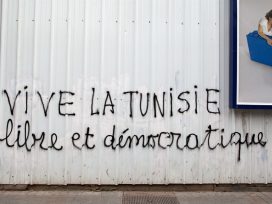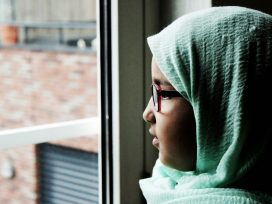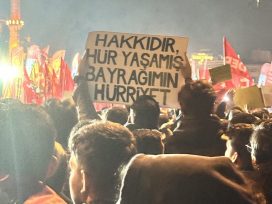The performative power of ‘Woman, Life, Freedom’
Women’s rights activists protesting for a democratic Iran counteract armed police on the streets with non-hierarchical leadership, a rhizomatic network, transnationality and flash mobs. Their momentum, supported globally via the Iranian diaspora, also benefits from a legacy of historic feminist action under extreme oppression.
Burning headscarves and dancing around the fire; dislodging clergymen’s turbans in public and sending them flying – the various, bold performative acts of Iran’s current revolution are having a huge impact.
Many call this combined action the first feminist revolution in Iran led by women, who no longer accept the deep humiliation meted out by an authoritarian regime. And yet, importantly, these protests are broadly upheld across the social spectrum; men are publicly demonstrating their support. And the movement has garnered solidarity from around the world; the role of the Iranian diaspora, its satellite broadcasts and social media are essential to the cause.
The courage of these young women and men today is also situated within a long history of women’s protests in Iran. Indeed, the previous, repeated calls of oppressed women may well be the subconscious wisdom behind this fight for a democratic Iran.
Symbol of modernity
Women were active participants in the 1979 Iranian revolution against the Pahlavi regime. Images of thousands of female protestors, often with their children, shouting slogans in the streets, surprised many people around the world. But their position as organized campaigners had been established over a period of more than forty years.
Reza Shah Pahlavi began his modernization plan for Iran with women as its symbol in 1936. However, his plans had paradoxical outcomes: some opportunities for women such as access to university education and job opportunities were created,1 but the government simultaneously banned all independent women’s groups and journals.2
In the 1960s and 1970s, Mohammad Reza Shah continued developing his father’s policies, which resulted in some additional legal benefits for women. Notably, women received the right to vote in 1963. Also the Family Protection Law of 1967 offered women increased protection in cases of divorce and over the custody of children. When revised, it additionally permitted free abortion on demand from 1974, and installed a restriction on polygyny and the right to alimony after divorce from 1976.
Under the last Shah of the Pahlavi dynasty, however, all independent women’s organizations were abolished. A new organization came into existence: the Women’s Organization of Iran (WOI), which, despite its dependency on the state, played a role in promoting women’s rights.3 In addition, the independent women’s movement did not stop when it was abolished and continued to have an important role in society. Both formal and informal women’s social, intellectual and political involvement were one of the reasons for their considerable participation in the revolution.
Symbol of Islam
A month after the Pahlavi regime was overthrown, women were out marching again – this time to protest the policies of Iran’s new rulers. Religious leaders who had praised women for their participation in the revolution now asked them to return to their homes.4 Compulsory veiling was the first step. Then, within just a few months post-revolution, the legal position of women worsened: ‘It took about forty years for secular feminists of the Pahlavi era to change the family law from the Civil Code of 1936 to the Family Protection Law of 1975,’ writes Palvin Paidar, but ‘in 1979, it took Ayatollah Khomeini one speech to demolish the Family Protection Law.’5
The size, variety and continuity of protests against the new restrictions on women were massive; those women who had been encouraged to leave the home to join the revolution were not willing to go back again.6 ‘Iranian women, more than any other time in the twentieth century, became aware of fundamental and important issues regarding their gender and reacted accordingly,’ writes Mehrangiz Kar.7
Women obtained a taste of freedom to decide about political, social, cultural and sexual aspects of their lives. The general picture of gender relations, in which women were attributed only a passive role regarding social and cultural developments, changed in this period. It was no longer taken for granted that they should stay at home as housewives and mothers, and be excluded from public decision-making.
Remembering the revolution
During the two years following the 1979 revolution, often referred to as ‘the spring of freedom’, several legally recognized political groups came into existence that advanced a wide range of ideologies, including forms of Marxism, Islamism and liberalism. Iranian women from different backgrounds could participate in all forms of social, cultural and political gatherings, extensively participating in decision-making processes at different levels in society.
Scenes on the streets changed dramatically. Nearby the University of Tehran, stands outside bookshops displayed material that was previously illegal: newly printed books, tapes of (international) revolutionary music, a multitude of newspapers from diverse political groups. In front of almost every stand, a group of people discussed political issues and plans for the future of the country. Men and woman of all ages and classes took part in passionate debates.
A woman from the Iranian diaspora explains this period well: ‘My sister once told me, “history has given us an intensive course”, and she was right. When I look back, I see the intensity of the events then was so great that you felt as if those events happened over thirty years. … I always look forward to having another time like that.”8
Paradise and hell
Such freedom was beautiful but didn’t last. Years of hope and optimism changed into years of fear and emptiness – a period called ‘the years of suppression’ by many. After no more than a few months post-revolution, various political groups began clashing. Although people were free to demonstrate and discuss politics on the streets, disagreements gradually took on more virulent forms. Occasional violent confrontations led to a decisive change of power in June 1981.
From that time onwards, brutal and bloody scenes dominated the streets of Iran, especially in Tehran. Whereas the first years of the revolution were associated with paradise, those who opposed the Islamists in power remember those days and the years that followed as hell. The symbolic use of ‘paradise’ and ‘hell’ to describe those events may seem somewhat exaggerated, but this is how many activists remember those years.
This change from years of activity and possibility to years of silence, fear and passivity had a strong psychological impact on women. Many expressed feelings of depression, saying they felt dead or lost.
A forced diaspora and isolation
The first half of the 1980s can be considered as one of the most oppressive periods in Iran’s recent history. The war with Iraq from 1980-88 began in that same period, which led to Iranian borders being closed for several years.
Many citizens had already been smuggled out and started new lives elsewhere by the time borders were reopened in the mid-1980s. The image of the new Iran was so negative, official trans-border movement was barely reactivated: it was almost impossible for Iranians to obtain travel visas from any western country even if they were able to acquire legal travel documents from the Iranian regime. Many Iranians left their country either with illegal exit documents or with illegitimate entry documents.
In addition, Iran was initially left behind much of the rest of the world in terms of technological developments, including online access. The war, the regime and Iran’s isolation resulted in a kind of ‘forced’ physical and virtual separation from the rest of the world. This had undeniable effects on both Iranians who had left and those who had stayed.
The Iranian regime significantly limited the transnational space for activism in the 1980s. Isolated and suppressed, activists had minimal access to the world beyond their locality. In the years following the end of the Iran-Iraq war, limitations were eased but only for a few.
The publication of newspapers and magazines was monopolized by those with connections to the ruling power. This was also the case for academic works. Individuals with any association to the political opposition were blocked from publishing and women activists were especially marginalized.
By the end of the 1990s, the national borders of Iran started opening up, both physically and virtually. Access to the Internet and limited cell phone availability provided a great chance for communication within and outside Iran. Emergent transnational spaces enabled new possibilities for empowered local protest, allowing women activists who had felt limited for years in rather closed local environments to reclaim their space in public.
Flourishing feminist movement
Participating in the revolution and becoming politically active had made many women aware of the importance of decision-making and their rights.9 Intensive post-revolution intervention then led many leftist women to partly transfer their political passion into strong secular feminist debate, both inside and outside Iran.10
Women’s issues, still overshadowed by the severe attack they had suffered directly after the revolution, were marginalized further during this highly politicized period, where more importance was given to political ideologies. During the 1980s and beginning of the 1990s, the Iranian Islamic framework made it impossible for feminists to openly express their secular identity. Secular and religious activists worked side by side to voice their protest against the Islamic republic’s anti-women policies.11
This collaboration was mainly focused on forming non-governmental organizations and establishing several women’s magazines such as Zanan (Women), Jens-e Dovom (Second Sex) and Fasl-e Zanan (the Season of Women).12 Articles in Zanan written by Shirin Ebadi and Mehrangiz Kar informed women of their legal rights.13 Later the Women’s Cultural Center was founded in 2000 and officially registered as NGO in 2001. Activities of these women’s rights activists included annual celebrations of International Woman’s Day on 8 March, seminars and conferences regarding issues such as ‘the serial killings of street women’,14 ‘Afghan women in exile in Iran’, ‘domestic violence’, and the publication of Nameye Zan, a regular newsletter.
Campaign strategy
After the 2005 election, Mahmoud Ahmadinejad’s hard-line administration made civil society activities near impossible. In response, activists turned their efforts towards campaigning. One of most well-known initiatives is the One Million Signatures Campaign, which demanded an end to discriminatory laws against women. The campaign against existing family law used various approaches ranging from in-person requests to writing articles, postcards, letters, emails and sending text messages to parliament to express concerns about anti-women laws. Other campaigns included Stop Stoning of Women aimed at creating consciousness about this brutal act.15 Many new groups and initiatives focusing on women’s rights were also formed such as the Feminist School website.
Before each election, greater tolerance for public discussions tends to transpire, providing an opportunity for activists to work with more focus and determination. Hamgaraee (literally meaning ‘convergence’, referred to in English as Women’s Coalition), a demand-driven group, put essential issues on the agenda for the 2009 presidential election, for example.16
Mahboubeh Abbasgholizadeh, a women’s rights activist who participated as a representative of the Women’s Coalition in the presidential debate stated, ‘for the first time in Iranian history, the demands of women to the presidential candidates are one of the main topics, with three of the four candidates expressing their programme on women’s issues.’17
Women’s rights activists in this period employed two key approaches. First, a non-violent strategy of dialogue that was neither ideological nor anti-ideology, appealing to those with diverse positions from different backgrounds; campaigns, which focused on women’s rights from all possible angles, were inclusive and therefore more effective. Second, they adapted a horizontal structure in the management of campaigns, enabling decision-making through in-depth discussions and voting; the movement’s leadership model, which can be described as ‘collective leadership’, unlike earlier hierarchical leadership models, ensured that no member was inferior to another.18
Suppression and prosecution
These various initiatives were established despite women’s rights activists being under constant attack by hardliners in power. All gatherings and campaigns, including peaceful demonstrations, were forcefully broken up. Participants were confronted with suppression and prosecution, causing many to seek refuge outside Iran.
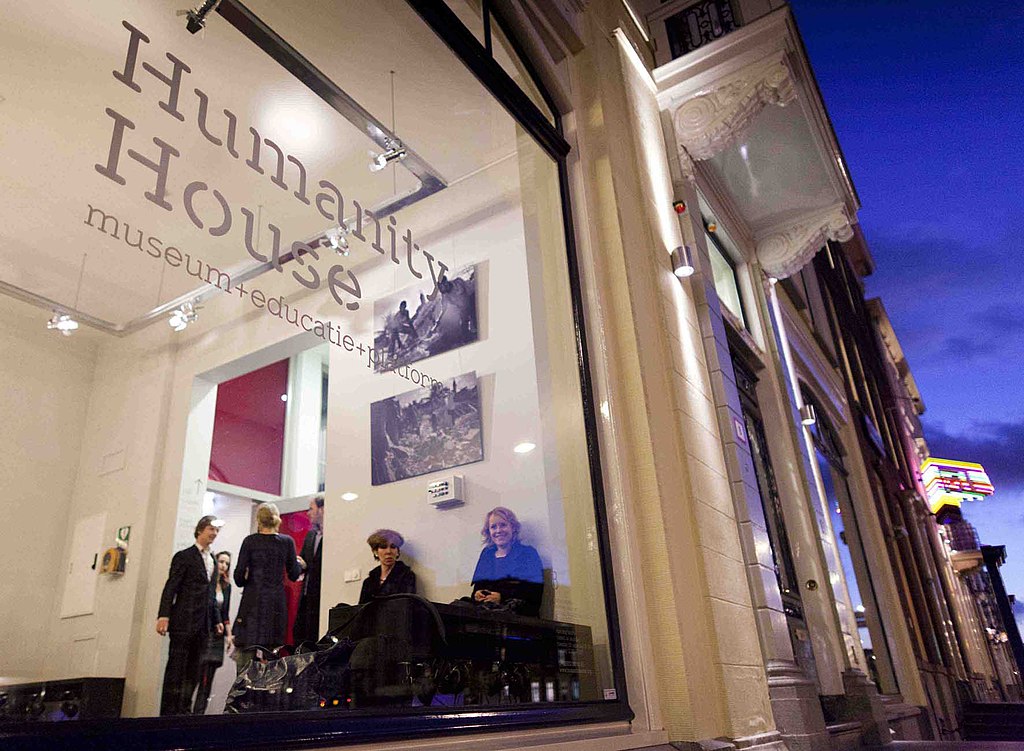
Photo by Poesiemau, CC BY-SA 3.0 via Wikimedia Commons
Those who continued their activities elsewhere became a source of connections between activists inside and outside Iran. The IWSF (Iranian Women’s Scientific Foundation) started its activities in 1990 and soon became the most active Iranian transnational diaspora organization on women’s issues.19 From Evin with Love, a more recent example, is an exhibition that was launched in 2018 at Humanity House in The Hague, a good example of an initiative that communicates the struggle and suppression of Iranian women to the rest of the world. The handicraft show, which has travelled throughout Europe, recounts the stories of women imprisoned in Evin Prison in Tehran.
Leadership in question
The current movement displays a series of distinctive traits. One main feature is its youth-oriented, horizontal form of leadership. As a rhizomatic network, the movement can sustainably counteract turbulent and suppressive societal elements. This type of non-hierarchical and inclusive approach by young people was arguably also the foundation of the Iranian Green Movement in 2009.20 However, in that instance, men took over without acknowledging women’s activism. Whereas Green Movement protestors were focused on reclaiming their votes and, therefore, reinforcing the legitimacy of power, the current movement is increasingly an attack on the foundations of this regime.
‘Women, Life, Freedom’ derives not only from accelerated frustrations but also from the need to seriously question the regime’s failed position on a variety of socio-political topics. Protests, which began in 2018, sequentially focused on economic (growing poverty), environmental (water shortages) and gender-based demands (violence against women). Mismanagement during the COVID 19 pandemic and the shooting down of a Ukrainian flight in 202021 intensified protestor outrage. After Mahsa Zina Amini’s death in custody in September 2022, the continuity of protests, their intensity and dispersed, networked nature, sets them apart from other movements this century in Iran. These qualities are crucial to being resistant to the regime.
Transnationality and technology
Another central feature of this movement is its global visibility through social media. Already during the Green Movement, the Twitter hashtag #iranelections was in the platform’s top five ‘trending topics’.22 ‘The use of social media became central to the emerging narrative about the potential for revolution or social change,’ writes Janet Alexanian.23 Since then, the role of social media has become even stronger. Video clips of acts of suppression and demonstrations have been shared around the world mainly through Instagram and WhatsApp. The channels had tens of millions of users when the Iranian government blocked them in response to the protests.
Iranians use circumvention software to side step one of the world’s most strict Internet censorship policies. In the absence of free media in Iran, social media has become a stronghold of democratic public debate. A good example is Clubhouse, a digital transnational space for anonymous participants who can discuss societal issues in up to ten-hour sessions. This transnational digital connection between Iranians, inside and outside the country, and their outreach to the rest of the world has been crucial for this movement’s huge global support.
Performative power
The most significant feature of this movement, however, is its performativity. Judith Butler has argued that performativity resists social norms.24 Songs of the current movement are melodic with lyrics based on daily conversations. The most popular song to emerge from the movement has lyrics made up of tweets, all of which begin with the Persian word baraye meaning ‘for’. Its strength is in its grassroots simplicity.
Baraye has been performed by groups of dancers around the world, including DC058 in the Netherlands. One impactful rendition was performed by Iranian actress Golshifteh Farahani during a Coldplay concert in Argentina. Additionally, various female artists perform Bella Ciao in Persian. These music and dance events are strong examples of transnational resistance. Performativity in this Iranian context communicates beyond borders and strongly conveys underlying feminist wisdom.25
Feminist wisdom
A close look at the present movement reveals traces of embedded wisdom from years of women’s rights activism in Iran. The roots of Iranian feminist activism run so deep it is a stretch to consider this wisdom as an intentional strategy. Rather it appears part of the tacit knowledge of the young women and men who started this revolution.
The slogan ‘Women, Life, Freedom’, at the movement’s core, calls for a dignified existence for all women who experience extreme forms of humiliation due to the Iranian regime’s dictate. After more than 100 days of protests, discussions among women’s rights activists and thinkers in Iran question whether this movement should be referred to as a feminist movement or not. However, the persistence of Iranian women activists in their struggle for justice and their achievements over the past decades suggest that the current movement carries feminist wisdom with it, even if one prefers not to call it a feminist movement. As with women’s rights activism early this century, this movement, while very political, is neither ideological nor anti-ideology in its democratic vision.
A. Najmabadi, “Hazards of Modernity and Morality: Women, state and ideology in contemporary Iran.” In Women, Islam and the State, ed. Deniz Kandiyoti, Macmillan, 1991, pp.48-77.
Ibid., pp. 62-63.
H. Esfandiari, “The Majles and Women’s Issues in the Islamic Republic of Iran.” In In the Eye of the Storm, Women in Post-revolutionary Iran, eds. M. Afkhami and E. Friedl, I.B. Tauris, 1994, pp.61–80.
P. Paidar “Feminism and Islam in Iran.” In Gendering the Middle East: Emerging Perspectives, ed. D. Kandiyoti, I.B.Tauris, 1996, p. 64.
V. M. Moghadam, Modernizing Women. Gender and Social Change in the Middle East, Lynne Rienner Publishers, 2003; Paidar, 1996.
M. Kar, “Women’s Political Rights in Iran Since the Revolution”, The Iranian Journal of International Affairs 7 (3): 659-75,1995, p. 662.
H. Ghorashi, “From Marxist Organizations to Feminism: Iranian Women’s Experiences of Revolution and Exile.” The Journal of the Study of Religions and Ideologies (J.S.R.I.), special issue on gender and ideologies, 6: 89-107, 2003.
H. Ghorashi, “Iranian Islamic and secular feminists, allies or enemies? A question rethought by participating in the NGO Forum during the Fourth International Women’s Conference in China.” MERA Occasional papers no. 27, Middle East Research Associates, 1996; H. Ghorashi, “Shifting and Conflicting Identities: Iranian women political activists in exile”, European Journal of Women’s Studies, 4: 283-303, 1997.
H. Ghorashi, 2003.
V. M. Moghadam, “Islamic Feminism and Its Discontents: Toward a resolution of the debate” Signs: Journal of women in culture and society, 27(4): 1135-1172, 2002.
For elaborate analysis of Zanan, see: A. Najmabadi, “Feminism in an Islamic Republic: ‘Years of Hardship, Years of Growth’.” In Islam, Gender and Social Change, eds. Y.Y. Haddad & J.L. Esposito, 59-84, Oxford University Press, 1998; and Z. Mir-Hosseini, “Stretching the Limits: A feminist reading of the Shari`a in post-Khomeini Iran.” In Feminism and Islam: Legal and literary perspectives, ed. M. Yamani, 285-319, Ithaca Press, 1996.
Shirin Ebadi is the winner of the Nobel Peace Prize 2004 and Mehrangiz Kar is a lawyer, who lived in Iran during this period and now lives abroad.
Recently screened and awarded movie The Holy Spider (2022) is based on the same story of serial killings of sex workers in Iran.
M. Abbasgholizadeh, “To do Something we are Unable to do in Iran: Cyberspace, the public sphere and the Iranian women’s movement”, Signs 39 (4): 831-840, 2014.
http://www.feministschool.com/spip.php?article2635, 2009, referred to in H. Ghorashi & R. Moghaddam, “Iranian Feminists and Transnational Contestations”, Labrys, Ètudes Féministes, Jan-July 2016, https://www.labrys.net.br/labrys29/monde/halleh.htm (last accessed 10 January 2023).
H. Ghorashi & R. Moghaddam, “Iranian feminists and transnational contestations”, 2016.
Ibid.
See Persian article: M. Shojaee, “Women’s movement a model for democracy”, http://www.roozonline.com/persian/opinion/opinion-article/article/-8cc37f9f59.html & Mitra Shojaee’s interview with feminist scholar Nayereh Tohidi and Iranian women activists, http://www.dw.com/fa-ir /a-5176886
On 8 January 2020, Ukraine International Airlines Flight 752 was shot down minutes after taking off from Tehran, Iran, by an Iranian surface-to-air missile.
D, Alinejad, Next Generation Diaspora: The formation of Iranian American-ness among second-generation migrant internet users in Los Angeles, thesis, Vrije Universiteit, 2015.
J. Alexanian, “Eyewitness Accounts and Political Claims: Transnational Responses to the 2009 Postelection Protests in Iran”, Comparative Studies of South Asia, Africa and the Middle East, 31 (2): 425–442, 2011.
J. Butler, Undoing Gender, Routledge, 2004.
This insight came from a conversation with Mansoureh Shojaee.
Published 23 January 2023
Original in English
First published by Eurozine
© Halleh Ghorashi / Eurozine
PDF/PRINTIn collaboration with
In focal points
- Living dead democracy
- Why Parliaments?
- Spelling out a law for nature
- No more turning a blind eye
- The end of Tunisia’s spring?
- Protecting nature, empowering people
- Albania: Obstructed democracy
- Romania: Propaganda into votes
- The myth of sudden death
- Hungary: From housing justice to municipal opposition
Newsletter
Subscribe to know what’s worth thinking about.
Related Articles
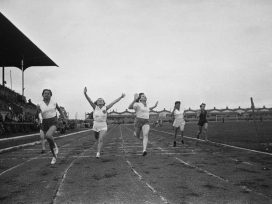
Women who take up running face all manner of challenges, from sexual harassment to overcoming body self-consciousness. Croatian journal Vox Feminae reflects on the sport’s development in Yugoslavia and its role today, including benefits for body, mind and connecting with the environment.
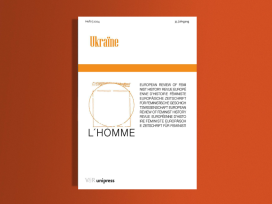
Hidden groundbreakers
L'Homme 1/2024
Localized political shifts have shaped Ukrainian women’s rights over the centuries: the Russian Empire once afforded property rights for aristocratic women in the south; socially active daughters of Greek-Catholic priests founded Galician societies under Habsburg rule; and forced migrants today forge new academic paths.

